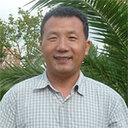CELLULASE6 and MANNANASE7 Affect Cell Differentiation and Silique Dehiscence.
Palavras-chave
Resumo
Cellulases, hemicellulases, and pectinases play important roles in fruit development and maturation. Although mutants with defects in these processes have not been reported for cellulase or hemicellulase genes, the pectinases ARABIDOPSIS DEHISCENCE ZONE POLYGALACTURONASE1 (ADPG1) and ADPG2 were previously shown to be essential for silique dehiscence in Arabidopsis (Arabidopsis thaliana). Here, we demonstrate that the cellulase gene CELLULASE6 (CEL6) and the hemicellulase gene MANNANASE7 (MAN7) function in the development and dehiscence of Arabidopsis siliques. We found that these genes were expressed in both vegetative and reproductive organs and that their expression in the silique partially depended on the INDEHISCENT and ALCATRAZ transcription factors. Cell differentiation was delayed in the dehiscence zone of cel6 and man7 mutant siliques at early flower development stage 17, and a comparison of the spatio-temporal patterns of CEL6 and MAN7 expression with the locations of delayed cell differentiation in the cel6 and man7 mutants revealed that CEL6 and MAN7 likely indirectly affect the timing of cell differentiation in the silique valve at this stage. CEL6 and MAN7 were also found to promote cell degeneration in the separation layer in nearly mature siliques, as cells in this layer remained intact in the cel6 and man7 mutants and the cel6-1 man7-3 double mutant, whereas they degenerated in the wild-type control. Phenotypic studies of single, double, triple, and quadruple mutants revealed that higher-order mutant combinations of cel6-1, man7-3, and adpg1-1 and adpg2-1 produced more severe silique indehiscent phenotypes than the corresponding lower-order mutant combinations, except for some combinations involving cel6-1, man7-3, and adpg2-1 Our results demonstrate that the ability of the silique to dehisce can be manipulated to different degrees by altering the activities of various cell wall-modifying enzymes.



